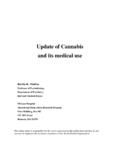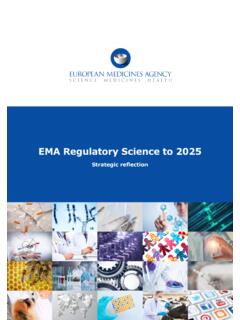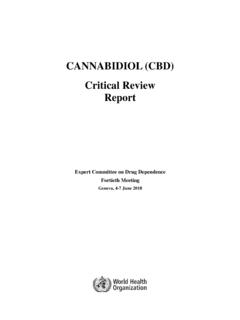Transcription of Guideline on Virus Safety Evaluation of Biotechnological ...
1 European Medicines Agency Evaluation of Medicines for Human Use London, 24 July 2008. Doc. Ref. EMEA/CHMP/BWP/398498/2005. CHMP/BWP. (COMMITTEE ABBREVIATION). Guideline ON Virus Safety Evaluation OF Biotechnological . INVESTIGATIONAL MEDICINAL PRODUCTS. DRAFT AGREED BY BWP May 2006. ADOPTION BY CHMPFOR RELEASE FOR CONSULTATION 28 June 2006. END OF CONSULTATION (DEADLINE FOR COMMENTS) 31 December 2006. AGREED BY BWP June 2008. ADOPTION BY CHMP 24 July 2008. DATE FOR COMING INTO EFFECT 1 February 2009. KEYWORDS Virus Safety , clinical trial, investigational medicinal products, IMPs 7 Westferry Circus, Canary Wharf, London, E14 4HB, UK. Tel. (44-20) 74 18 84 00 Fax (44-20) 74 18 85 45. E-mail: EMEA 2008 Reproduction and/or distribution of this document is authorised for non commercial purposes only provided the EMEA is acknowledged Guideline ON Virus Safety Evaluation OF Biotechnological .
2 INVESTIGATIONAL MEDICINAL PRODUCTS. TABLE OF CONTENTS. EXECUTIVE 3. 1. INTRODUCTION .. 3. 2. 3. 3. LEGAL BASIS .. 3. 4. MAIN Guideline TEXT .. 3. GENERAL PRINCIPLES .. 3. ASSURING THE VIRAL Safety OF Biotechnological IMPS .. 4. Cell line qualification: testing for viruses .. 4. Raw materials of biological origin .. 4. Testing for viruses in unprocessed bulk .. 4. Validation of Virus reduction .. 5. Description and Qualification of Analytical Procedures .. 7. Virus Safety RISK 8. RE- Evaluation OF VIRAL Safety DURING DEVELOPMENT .. 8. FORMAT OF CLINICAL TRIAL AUTHORISATION 8. REFERENCES (SCIENTIFIC AND/OR LEGAL) .. 9. EMEA 2008 Page 2/9. EXECUTIVE SUMMARY. The purpose of this document is to provide scientific guidance relating to the viral Safety of Biotechnological medicinal products used in clinical trials.
3 Guidance is provided with respect to: (i) the criteria for and the extent of viral Safety Evaluation studies, that are required prior to and during clinical development. (ii) the extent to which manufacturers are able to refer to in-house experience concerning Virus Safety Evaluation . (iii) the risk assessment which should form part of the Safety Evaluation . 1. INTRODUCTION. Assuring the viral Safety of Biotechnological medicinal products is a complex process and a reliable assessment of the viral Safety of an investigational medicinal product (IMP) is critical. This Guideline provides advice on the viral Safety data and documentation that should be submitted in a request for authorisation of a clinical trial of a human Biotechnological medicinal product. Reference is made to ICH Q5A (see references), which defines data requirements for marketing authorisation applications (MAA).
4 Although Q5A does not provide specific guidance for Biotechnological products in clinical development, the basic principles remain pertinent and applicable. The Guideline provides for a harmonised approach throughout the European Union, for both sponsors and regulators, with regard to assessment of viral Safety of Biotechnological IMPs during clinical development. This will be especially beneficial for multi-centre studies, potentially involving several different member states. 2. SCOPE. This Guideline applies to human Biotechnological IMPs prepared from cells cultivated in vitro from characterised cell banks of human or animal origin as described in Q5A. Many IMPs are derived from well-characterised rodent cell lines such as CHO, NS0 or SP2/0, although a variety of other cell lines are in use and under development and should be considered on a case-by-case basis.
5 The Guideline covers monoclonal antibodies and recombinant DNA derived IMPs including recombinant subunit vaccines. It does not apply to IMPs that contain recombinant viruses or bacteria (both replicative and non-replicative), or live attenuated or inactivated vaccines. IMPs derived from hybridoma cells grown in vivo are also excluded from the scope of this Guideline . This Guideline outlines the viral Safety requirements applicable to all stages of clinical development of an IMP. The Guideline does not apply to IMPs to be used solely for non-clinical testing. ICH Q5A. provides guidance on data required to support MAAs. 3. LEGAL BASIS. Clinical trials within the EU are regulated by Directive 2001/20/EC (see references) and investigational medicinal products used in trials should be manufactured according to the principles of Good Manufacturing Practice Approval of trials is the responsibility of individual Member States, which are required to evaluate the products used in clinical studies.
6 4. MAIN Guideline TEXT. General Principles The aim of Virus Safety studies for Biotechnological IMPs is to demonstrate an acceptable level of Safety for clinical trial subjects. The viral Safety of a licensed Biotechnological medicinal product is assured by three complementary approaches involving (i) selecting and testing cell lines and other raw materials of human or animal origin for viral contaminants, (ii) assessment of the capacity of downstream processing to clear EMEA 2008 Page 3/9. infectious viruses and (iii) testing the product at appropriate steps for contaminating viruses (see ICH. Q5A). For a Biotechnological IMP, due to the developmental nature of the manufacturing process and of the product, a reduced programme of studies on assuring viral Safety is envisaged compared with the data requirements for marketing authorisation; firstly, for testing for viruses in end of production cells/unprocessed bulk (see Section ) and secondly, for studies on the validation of Virus reduction (see Section ).
7 Such a reduced programme would only be applicable for cell lines classified in ICH Q5A as Case A' or Case B'. Demonstrated in-house experience (see Section ). could also contribute to a reduced package of studies on Virus reduction. In addition to the provision of data, a risk assessment should be made taking into account some or all of the following factors: the nature and history of the cell line, the extent of characterisation of the cell line, use of raw materials of human and/or animal origin during manufacture and their control, potential for product exposure to adventitious contamination, experience of the manufacturer with the cell line involved, experience of the manufacturer with specific Virus reduction procedures to be used, published data. Assuring the viral Safety of Biotechnological IMPs Cell line qualification: testing for viruses Testing of the master cell bank (MCB) for viral contaminants should be performed as described in Q5A prior to the initiation of a Phase I trial.
8 A working cell bank (WCB) might only be set up during clinical development and thus, for some Biotechnological IMPs being used early in clinical development, it may not yet have been established. When established, the first WCB should in principle be tested as outlined in ICH Q5A. However, where unprocessed bulks are tested as described in Section 1, testing of cells at the limit of in vitro cell age is not required. Since endogenous retroviral viruses or particles are present in most cell lines currently in use and there is a probability that they will be present in a novel cell line, particular attention should be paid to investigating the cell line for their presence. Raw materials of biological origin The viral Safety Evaluation of Biotechnological IMPs should take into account biological raw materials (especially animal or human derived) used in production.
9 A risk-based assessment focusing on the type and origin of the raw material, its process conditions and testing, as well as its use in the manufacture of the medicinal product and tests applied to the unprocessed bulk material, is an acceptable approach to the Evaluation of its viral Safety (see also Section ). Appropriate documentation should be provided regarding the viral Safety of raw material of biological origin. Reference is made to guidance documents on bovine sera as well as on minimising the risk for transmission of animal spongiform encephalopathy (see references). Testing for viruses in unprocessed bulk Independent of the stage of development, each batch of unprocessed bulk material that will be used to manufacture clinical trial material should be tested as per Q5A. The sample to be tested should include cells, when appropriate, and tests should include in vitro and PCR-based screening tests for adventitious agents and an estimation of retroviral particles, where applicable.
10 No further testing is required for bulks deriving from CHO cell lines. For manufacture based upon NS0 or Sp2/0 cell lines, tests for infectious retroviruses should be applied on a one-off basis but should be repeated if there is a significant change in production cell culture, manufacturing scale. For manufacture based upon EMEA 2008 Page 4/9. any other cell line, tests for infectious retroviruses and in vivo tests (as per section of ICH Q5A). should be applied on a one-off basis, but should be repeated if there is a significant change in production cell culture, manufacturing scale. These testing recommendations are shown in Table 1. Consideration should be given to the inclusion of a test for MMV if the cell line is permissive for this Virus . The source and viral Safety of the raw materials used during cell culture should be taken into account when devising the unprocessed bulk testing (see also Section ).













